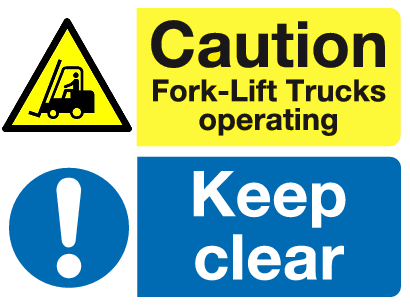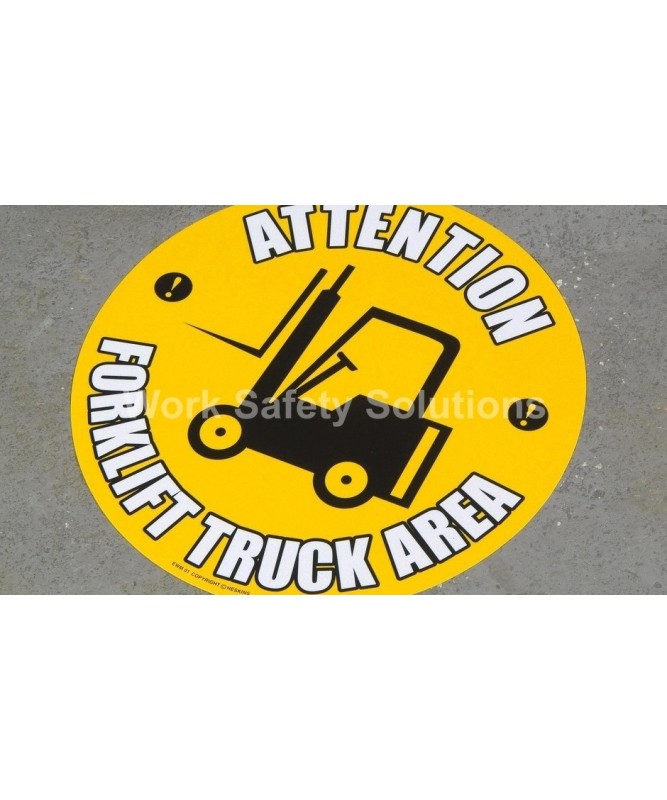Forklift Signs-- Increase Safety Awareness in High-Traffic Locations
Trick Considerations for Designing Effective Forklift Safety And Security Signs
When making effective forklift safety indications, it is critical to consider a number of basic factors that collectively make sure ideal exposure and clarity. High-contrast shades coupled with large, understandable sans-serif font styles considerably boost readability, particularly in high-traffic locations where fast understanding is essential. forklift signs. Strategic positioning at eye level and using durable materials like aluminum or polycarbonate additional add to the long life and performance of these indicators. Adherence to OSHA and ANSI guidelines not just systematizes safety and security messages yet additionally strengthens conformity. To totally grasp the ins and outs and finest methods included, a number of extra considerations benefit closer focus.
Color and Contrast
While developing forklift safety signs, the selection of shade and contrast is paramount to ensuring presence and performance. Colors are not just visual elements; they serve crucial useful objectives by communicating specific messages promptly and decreasing the danger of accidents. The Occupational Safety And Security and Health And Wellness Management (OSHA) and the American National Specification Institute (ANSI) give guidelines for making use of colors in safety indications to standardize their definitions. Red is usually used to signify immediate threat, while yellow signifies caution.
Reliable comparison between the background and the message or symbols on the indication is just as essential. High comparison ensures that the indication is readable from a distance and in varying lighting problems. Black text on a yellow background or white text on a red history are combinations that stand out prominently. Furthermore, making use of reflective materials can enhance exposure in low-light settings, which is often a consideration in storehouse setups where forklifts operate.
Making use of ideal shade and comparison not just sticks to regulatory standards however likewise plays a crucial duty in preserving a secure workplace by ensuring clear communication of risks and directions.

Font Style Size and Design
When creating forklift safety and security signs, the selection of typeface dimension and style is vital for guaranteeing that the messages are legible and quickly recognized. The main purpose is to improve readability, especially in environments where quick data processing is crucial. The typeface size should be huge enough to be read from a range, fitting varying view problems and making certain that employees can understand the indication without unneeded stress.
A sans-serif font style is normally suggested for safety indicators due to its tidy and simple appearance, which boosts readability. Fonts such as Arial, Helvetica, or Verdana are often liked as they lack the detailed details that can cover critical details. Uniformity in font style throughout all security indicators aids in developing an uniform and specialist appearance, which better reinforces the relevance of the messages being conveyed.
Additionally, focus can be achieved via calculated use of bolding and capitalization. Keyword or phrases can be highlighted to draw prompt attention to essential guidelines or warnings. Overuse of these techniques can result in visual mess, so it is important to apply them carefully. By carefully selecting proper font dimensions and designs, forklift safety and security indications can efficiently interact critical safety info to all workers.
Positioning and Visibility
Guaranteeing optimal positioning and presence of forklift safety and security indicators is extremely important in commercial setups. Correct sign placement can significantly decrease the risk of accidents and enhance general office safety and security. Indications must be placed at eye level to guarantee they are quickly recognizable by drivers and pedestrians. This commonly suggests positioning them in between 4 and 6 feet from the ground, depending upon the typical height of the labor force.

Indications must be well-lit or made from reflective products in dimly lit areas to guarantee they are visible at all times. By diligently thinking about these their explanation elements, one can guarantee that forklift security indications are both efficient and noticeable, thereby fostering a much safer working atmosphere.
Material and Toughness
Picking the appropriate products for forklift safety and security indicators is critical to ensuring their longevity and effectiveness in industrial environments. Given the harsh conditions typically experienced in storage facilities and producing facilities, the materials chosen have to hold up against a selection of stress factors, consisting of temperature fluctuations, moisture, chemical direct exposure, and physical influences. Sturdy substratums such as light weight aluminum, high-density polyethylene (HDPE), and polycarbonate are prominent choices due to their resistance to these components.
Light weight aluminum is renowned for its toughness and corrosion resistance, making it an excellent selection for both interior and outside applications. HDPE, on the other hand, supplies outstanding effect resistance and can endure prolonged direct exposure to extreme chemicals without breaking down. Polycarbonate, known for its high influence stamina and clarity, is often made use of where exposure and resilience are critical.
Just as essential is the sort of printing used on the indications. UV-resistant inks and safety coatings can substantially boost the lifespan of the signs by preventing fading and wear triggered by long term exposure to sunlight and various other environmental elements. Laminated or screen-printed surface areas provide extra layers of defense, guaranteeing that the essential safety info continues to be legible gradually.
Buying high-quality materials and durable production refines not only extends the life of forklift safety indications but also enhances a culture of safety within the work environment.
Compliance With Regulations
Following regulative requirements is extremely important in the design and deployment of forklift safety indications. Compliance makes sure that the signs are not only efficient in conveying important security info yet additionally fulfill lawful commitments, therefore mitigating potential liabilities. Various organizations, such More about the author as the Occupational Safety and Health Management (OSHA) in the United States, offer clear guidelines on the specifications of safety and security indicators, consisting of color pattern, message size, and the addition of widely recognized symbols.
To adhere to these regulations, it is vital to perform a detailed evaluation of suitable standards. For example, OSHA mandates that safety and security indications should be visible from a range and consist of certain colors: red for danger, yellow for care, and eco-friendly for security instructions. Additionally, sticking to the American National Specification Institute (ANSI) Z535 series can better improve the effectiveness of the indicators by standardizing the design aspects.
Moreover, normal audits and updates of safety indications should be done to guarantee recurring conformity with any adjustments in policies. Involving with accredited safety and security experts throughout the continue reading this style phase can additionally be useful in making sure that all regulatory demands are met, which the indicators serve their desired purpose properly.
Conclusion
Creating effective forklift security signs needs mindful interest to color contrast, font dimension, and design to make sure optimum visibility and readability. Strategic placement at eye degree in high-traffic locations enhances understanding, while the usage of resilient materials makes sure long life in various environmental conditions. Adherence to OSHA and ANSI standards systematizes safety and security messages, and incorporating reflective materials boosts presence in low-light scenarios. These considerations collectively add to a much safer working setting.